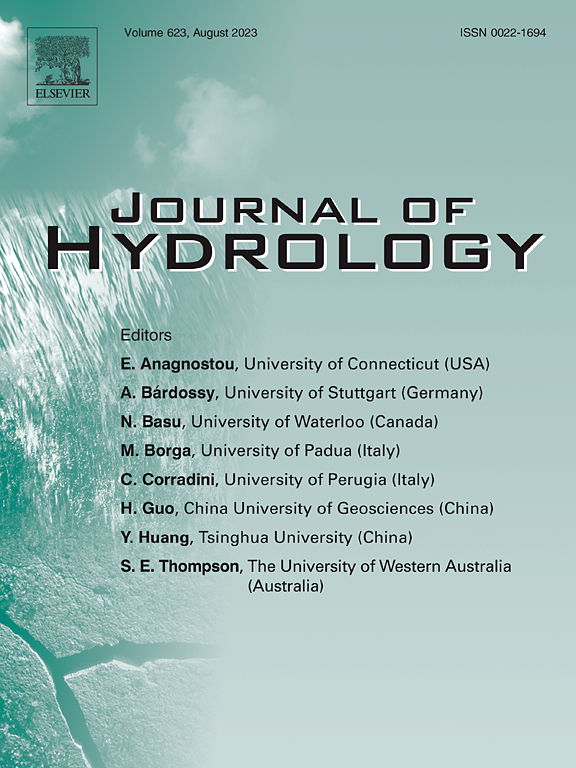Improving terrestrial evapotranspiration estimation of the Tibetan Plateau by coupling SEBS with machine learning-derived aerodynamic resistance
IF 6.3
1区 地球科学
Q1 ENGINEERING, CIVIL
引用次数: 0
Abstract
Land evapotranspiration (ET) on the Qinghai–Tibet Plateau (TP) is crucial for regulating worldwide atmospheric circulation. This research explores the integration of machine learning (ML) with a physical framework to improve ET estimation. We developed a coupled model that combines the surface energy balance system (SEBS) model with ML algorithms (SEBS-ML) to estimate ET effectively. Specifically, we employed the random forest (RF) algorithm to estimate aerodynamic resistance (ra), which significantly influences the turbulent transport between the surface and air. We evaluated the instantaneous and daily ET estimates using data from 17 eddy covariance flux tower sites and compared these estimates with those derived from three other ML strategies: linear regression (LR), ridge regression (RR), and support vector machine regression (SVM). We also compared the hybrid model with the SEBS model and pure machine learning strategy (PML). The results indicate that RF provides the most accurate estimates of daily ET among the 4 hybrid models, with R2 and Kling–Gupta efficiency (KGE) values equal to 0.70 and 0.82. SVM performed less effectively than RF, while LR and RR were the least effective. The ensemble learning approach in the RF model appears to reduce the bias of the ensemble results by compensating for individual tree biases. Under extreme conditions, the hybrid model demonstrates superior generalization capability, with a relatively low energy irrationality rate and better extrapolation performance compared to the PML model.. The enhanced strategy enhances the quality of ET estimates but also adheres to physical constraints, thereby preventing the generation of implausible results. This research introduces an innovative approach for estimating ET that enhances the physical mechanisms and performance of the SEBS model, thereby improving its precision and scalability. This model provides vital insights into the hydrological and climatic changes occurring on the TP.
基于SEBS和机器学习气动阻力的青藏高原地表蒸散发估算方法的改进
青藏高原陆地蒸散发(ET)对全球大气环流具有重要的调节作用。本研究探索了机器学习(ML)与物理框架的集成,以改进ET估计。我们开发了一个将表面能量平衡系统(SEBS)模型与ML算法(SEBS-ML)相结合的耦合模型来有效地估计ET。具体来说,我们采用随机森林(RF)算法来估计空气动力阻力(ra),这对地面和空气之间的湍流传输有重要影响。我们使用来自17个涡动相关通量塔站点的数据评估了瞬时和每日ET估计,并将这些估计与其他三种ML策略(线性回归(LR),脊回归(RR)和支持向量机回归(SVM))的估计进行了比较。我们还将混合模型与SEBS模型和纯机器学习策略(PML)进行了比较。结果表明,在4种混合模型中,RF模型对日蒸散发的估计最为准确,R2和KGE分别为0.70和0.82。SVM的效果不如RF,而LR和RR的效果最差。RF模型中的集成学习方法似乎通过补偿单个树的偏差来减少集成结果的偏差。在极端条件下,与PML模型相比,混合模型具有较低的能量不合理率和较好的外推性能,具有较好的泛化能力。改进后的策略提高了ET估计的质量,但也遵守物理约束,从而防止产生不可信的结果。本研究引入了一种创新的估算ET的方法,增强了SEBS模型的物理机制和性能,从而提高了其精度和可扩展性。该模型为青藏高原上发生的水文和气候变化提供了重要的见解。
本文章由计算机程序翻译,如有差异,请以英文原文为准。
求助全文
约1分钟内获得全文
求助全文
来源期刊

Journal of Hydrology
地学-地球科学综合
CiteScore
11.00
自引率
12.50%
发文量
1309
审稿时长
7.5 months
期刊介绍:
The Journal of Hydrology publishes original research papers and comprehensive reviews in all the subfields of the hydrological sciences including water based management and policy issues that impact on economics and society. These comprise, but are not limited to the physical, chemical, biogeochemical, stochastic and systems aspects of surface and groundwater hydrology, hydrometeorology and hydrogeology. Relevant topics incorporating the insights and methodologies of disciplines such as climatology, water resource systems, hydraulics, agrohydrology, geomorphology, soil science, instrumentation and remote sensing, civil and environmental engineering are included. Social science perspectives on hydrological problems such as resource and ecological economics, environmental sociology, psychology and behavioural science, management and policy analysis are also invited. Multi-and interdisciplinary analyses of hydrological problems are within scope. The science published in the Journal of Hydrology is relevant to catchment scales rather than exclusively to a local scale or site.
 求助内容:
求助内容: 应助结果提醒方式:
应助结果提醒方式:


